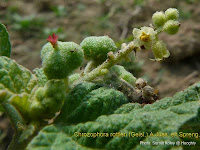
 Chrozophora rottleri (Geiseler) A.Juss. ex Spreng.
Chrozophora rottleri (Geiseler) A.Juss. ex Spreng.Family: Euphorbiaceae
Vernakular names in India: dekha chowkdi, dekha-chowkdi, erra miriyam, gubra, gurugu, khakaguddi, khudi-okra, linga menasu, linga mirapa, lingamenasu, shadevi, sonballi, souballi, subali, suravarta, surya-varti, suryavarta
Description: es alternate, 2-5 x 1-4 cm, rounded or obtuse at apex, rounded or subtruncate at base, entire or shallowly crenate-sinuate, 3-5-veined from base, somewhat bullate above when young, becoming less so with age, pubescent above, densely so beneath; petiole 1-4 cm long, densely stellate-pubescent; stipules 2 mm long, linear. Inflorescence 1-5 cm long, leaf-opposed. Male flowers: pedicels 1 mm long; sepals c. 3 mm long, lanceolate, stellate-pubescent; petals pink, 3 mm long, elliptic-oblong, lepidote without; stamens 15, united into 4 mm tall column; anthers 1 mm long. Female flowers: pedicels c. 5 mm long, extending up to 1.5 cm or more in fruit; sepals 1.5-2 mm long, linear-lanceolate, stellate-pubescent; petals minute or absent. Ovary 2 mm diameter, densely stellate-pubescent; styles 1-1.5 mm long, bifid almost from base, stellate-pubescent without, densely papillose within. Fruit 4 x 7 mm, rounded, 3-lobed, stellate-pubescent; seeds 3-3.5 x 2-2.5 mm, globose-ovoid, grey.
Used in Ayurveda. Plant acrid, poisonous, emetic, cathartic, drastic corrosive. Leaves depurative, seeds purgative; ashes of the roots administered to children for cough; root powder given with water in cough and cold. Leaves chewed to treat leucoderma; crushed leaves applied in sunburn and sunstroke. Fish poison. Veterinary medicine, leaves used in the treatment of skin diseases on neck of horses. [CRC World Dictionary of Medicinal and Poisonous Plants]
Published articles of Chrozophora rottleri





